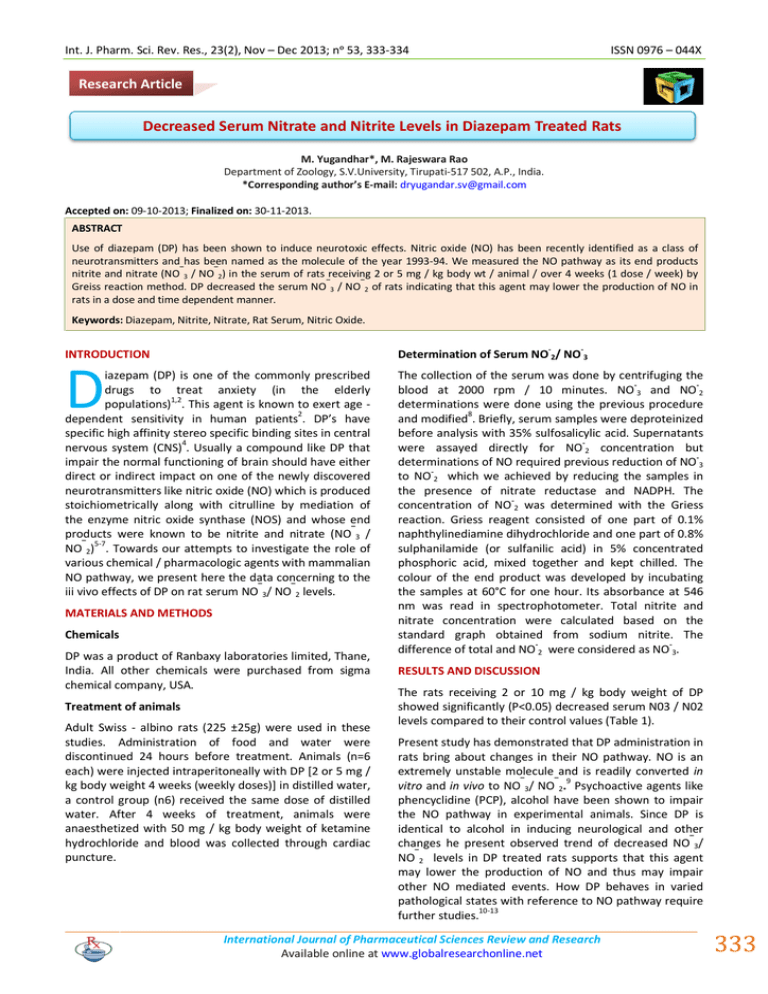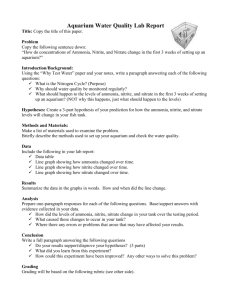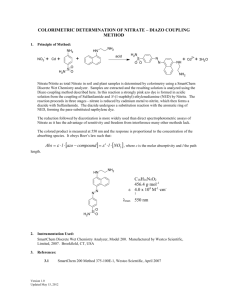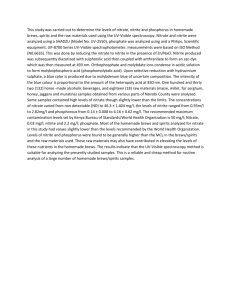Document 13309480
advertisement

Int. J. Pharm. Sci. Rev. Res., 23(2), Nov – Dec 2013; nᵒ 53, 333-334 ISSN 0976 – 044X Research Article Decreased Serum Nitrate and Nitrite Levels in Diazepam Treated Rats M. Yugandhar*, M. Rajeswara Rao Department of Zoology, S.V.University, Tirupati-517 502, A.P., India. *Corresponding author’s E-mail: dryugandar.sv@gmail.com Accepted on: 09-10-2013; Finalized on: 30-11-2013. ABSTRACT Use of diazepam (DP) has been shown to induce neurotoxic effects. Nitric oxide (NO) has been recently identified as a class of neurotransmitters and has been named as the molecule of the year 1993-94. We measured the NO pathway as its end products ‾ ‾ nitrite and nitrate (NO 3 / NO 2) in the serum of rats receiving 2 or 5 mg / kg body wt / animal / over 4 weeks (1 dose / week) by ‾ ‾ Greiss reaction method. DP decreased the serum NO 3 / NO 2 of rats indicating that this agent may lower the production of NO in rats in a dose and time dependent manner. Keywords: Diazepam, Nitrite, Nitrate, Rat Serum, Nitric Oxide. - INTRODUCTION - Determination of Serum NO 2/ NO 3 D iazepam (DP) is one of the commonly prescribed drugs to treat anxiety (in the elderly populations)1,2. This agent is known to exert age dependent sensitivity in human patients2. DP’s have specific high affinity stereo specific binding sites in central nervous system (CNS)4. Usually a compound like DP that impair the normal functioning of brain should have either direct or indirect impact on one of the newly discovered neurotransmitters like nitric oxide (NO) which is produced stoichiometrically along with citrulline by mediation of the enzyme nitric oxide synthase (NOS) and whose end products were known to be nitrite and nitrate (NO‾3 / NO‾2)5-7. Towards our attempts to investigate the role of various chemical / pharmacologic agents with mammalian NO pathway, we present here the data concerning to the iii vivo effects of DP on rat serum NO‾3/ NO‾2 levels. MATERIALS AND METHODS Chemicals DP was a product of Ranbaxy laboratories limited, Thane, India. All other chemicals were purchased from sigma chemical company, USA. Treatment of animals Adult Swiss - albino rats (225 ±25g) were used in these studies. Administration of food and water were discontinued 24 hours before treatment. Animals (n=6 each) were injected intraperitoneally with DP [2 or 5 mg / kg body weight 4 weeks (weekly doses)] in distilled water, a control group (n6) received the same dose of distilled water. After 4 weeks of treatment, animals were anaesthetized with 50 mg / kg body weight of ketamine hydrochloride and blood was collected through cardiac puncture. The collection of the serum was done by centrifuging the blood at 2000 rpm / 10 minutes. NO-3 and NO-2 determinations were done using the previous procedure and modified8. Briefly, serum samples were deproteinized before analysis with 35% sulfosalicylic acid. Supernatants were assayed directly for NO-2 concentration but determinations of NO required previous reduction of NO-3 to NO-2 which we achieved by reducing the samples in the presence of nitrate reductase and NADPH. The concentration of NO-2 was determined with the Griess reaction. Griess reagent consisted of one part of 0.1% naphthylinediamine dihydrochloride and one part of 0.8% sulphanilamide (or sulfanilic acid) in 5% concentrated phosphoric acid, mixed together and kept chilled. The colour of the end product was developed by incubating the samples at 60°C for one hour. Its absorbance at 546 nm was read in spectrophotometer. Total nitrite and nitrate concentration were calculated based on the standard graph obtained from sodium nitrite. The difference of total and NO-2 were considered as NO-3. RESULTS AND DISCUSSION The rats receiving 2 or 10 mg / kg body weight of DP showed significantly (P<0.05) decreased serum N03 / N02 levels compared to their control values (Table 1). Present study has demonstrated that DP administration in rats bring about changes in their NO pathway. NO is an extremely unstable molecule and is readily converted in ‾ ‾ 9 vitro and in vivo to NO 3/ NO 2. Psychoactive agents like phencyclidine (PCP), alcohol have been shown to impair the NO pathway in experimental animals. Since DP is identical to alcohol in inducing neurological and other changes he present observed trend of decreased NO‾3/ NO‾2 levels in DP treated rats supports that this agent may lower the production of NO and thus may impair other NO mediated events. How DP behaves in varied pathological states with reference to NO pathway require further studies.10-13 International Journal of Pharmaceutical Sciences Review and Research Available online at www.globalresearchonline.net 333 Int. J. Pharm. Sci. Rev. Res., 23(2), Nov – Dec 2013; nᵒ 53, 333-334 ISSN 0976 – 044X ‾ Table 1: Levels of Nitrite and Nitrate in the Serum of Diazepam treated rats (Values expressed as ng NO 2 ml of serum). Rat Serem Control Diazepam Treated (50mg/kg body wt) 2 Weeks 5 Weeks ‾ Nitrite (NO 2) Levels AV SD PC t-test 37.40 5.49 0.64 3.71 P<0.05 * 5.04 0.97 P<0.05 * 18.59 2.70 6.63 1.81 P<0.05 * 4.56 1.20 P<0.05 * ‾ Nitrate(NO 3)Levels AV SD PC t-test Values expressed as the mean S.D of 6 samples; AV: Average; SD: Standard deviation; PC: Percent change over control; NS: Not Significant; * p< 0.001 CONCLUSION Diazepam administration in rats appear to inhibit the cellular / organ based NO production which may result in lowered serum NO‾3/ NO‾2 pools as observed from our present study. 7. Guarner C, Soriano G, Tomas A, Bulbena 0, Novella MT, Balonzo J, Vilardell F, Mourelle M and Moncada S. Increased serum nitrite and nitrate levels in patients with cirrhosis: relationships to endotoxenia. Hepatology, 18, 1993, 1139 - 1143. 8. Marietta M.A, Yoon PS, Iyengar R, Leaf CD and Wishnok J.S.. Macrophage oxidation of L-arginine to nitrite and nitrate: nitricoxide is an intermediate. Biochemistry, 27, 1988, 8706 - 8711. 9. Knowles R.G, Merret M, Salter M and Moncada S. Antiinflammatory glucocorticoids inhibit the induction by endotoxin of nitricoxide synthase in the lung, liver and aorta of the rat. Biochem. J. 270, 1990, 833 - 836. REFERENCES 1. Miller L. Effects of chronic drug use defining our terms. J. Clin. Phychopharmacol, 8, 1988, 300-311. 2. Squires RF & Bracstrup C. Benzodiazepire receptors in rat brain. Nature, 226, 1977, 732-734. 3. Kruse W.H.H, Problems and pitfalls in the use of benzodiazepines in the elderly. Drug safety, 5, 1990, 328 344. 4. Uhienhuth, E.H., We Wit, H., Batter, MB., Johanson, CE., and Mellinger, G.W. Risks & benefits of long - term benzodiazepine use. J. Clin. Psychopharmacol, 8, 1988, 161167. 10. Osava Y and Davila J.C. Phencyclidine, a psychotomimetic agent and drug of abuse, is a suicide inhibitor of brain nitric oxide synthase Biochem. Biophys. Res. Commun, 194, 1993,1435 -1439. 11. Oshita M, Takel A and Kawano Y., J. Cm. Invest, 91, 1993,1337. 5. Bredt DS and Suyder SH. Isolation of nitricoxide synthetase, a calmodulin reqiring enzyme Proc. Nati. Acad. Sci (USA), 87, 1990, 682 - 685. 12. Rajeswara Rao, M, Hutcheson A.E and Markov AK. Changes in the cardiovascular nitricoxide pathway in cyclosporin A treated rats. Drug. Chem. Toxicol, 1997. 6. Ciraulo, D.A, Sands BF and Shader RI, Critical review of liability for benzodiazepine abuse among alcoholic AM. 3. Psychiatry, 145, 1988, 1501 - 1506. 13. Rego A, Vargas R, Foegh ML and Ramwell P.W Effect of cyclosporine A treatment on vascular reactivity of the rat thoracic aorta. Tramplent, Proc, 20, 1988, 572 - 577. Source of Support: Nil, Conflict of Interest: None. International Journal of Pharmaceutical Sciences Review and Research Available online at www.globalresearchonline.net 334




